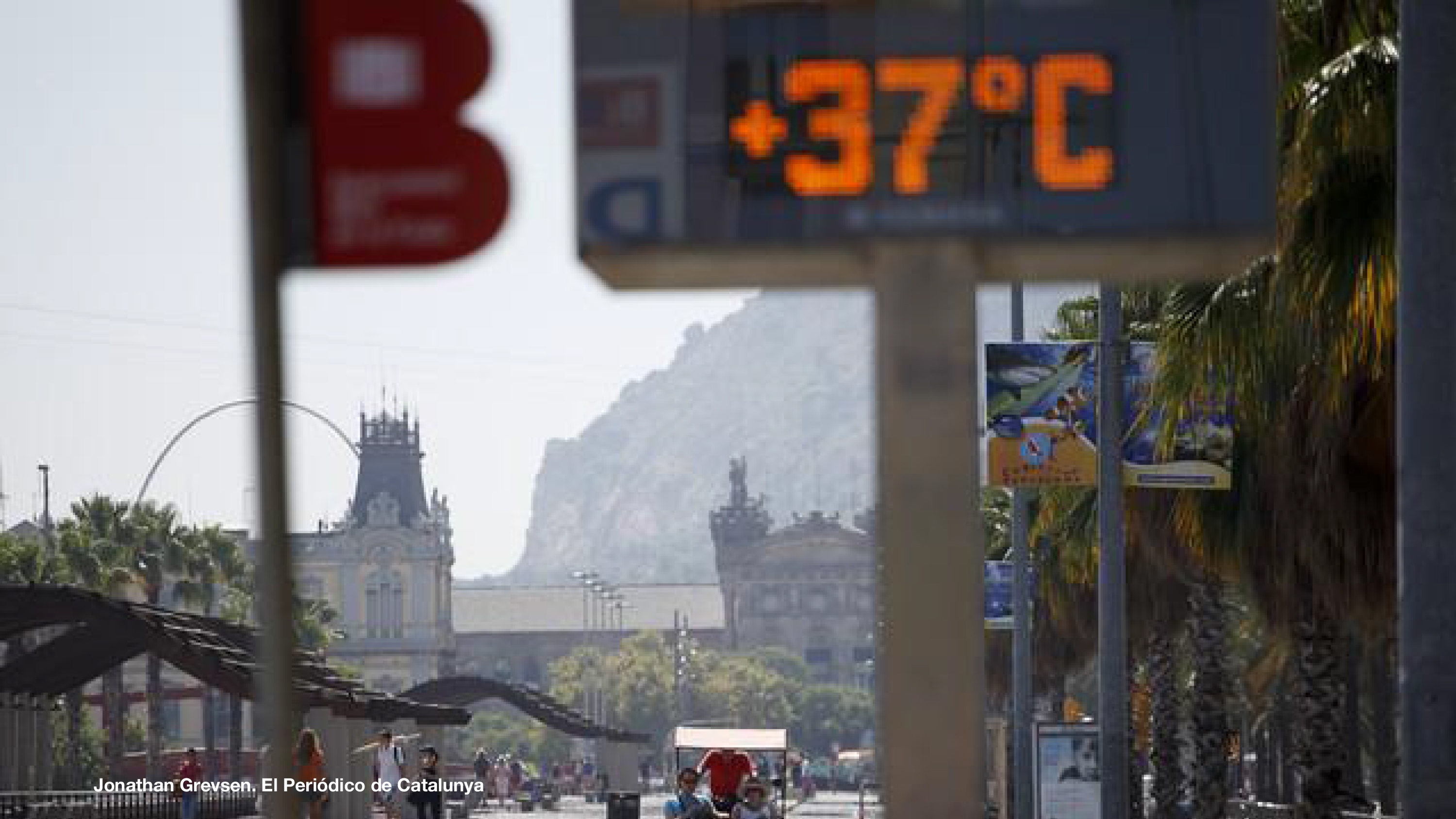 Source: Jonathan Grevsen
Source: Jonathan GrevsenHow is Barcelona coping with climate change? This analysis provides recommendations to further adapt to climate change. Barcelona has 3.2 million people within its sprawling barrios. Density reaches 16, 315/km² and in comparison, Manhattans density is 10,194/km². Barcelonans average age is 43 years old, and the age structure here is noteworthy. 20% of its citizens are over 65 years old. 20% of Barcelona’s active population are unemployed. Barcelona has a significant immigrant population at 19.1%.
Energy consumption in Barcelona in 2008 reached 17,000 GWh, with 44% being electricity and 32% being natural gas consumption. Spain produces 30% of its own energy, with the rest being imported. 70% of Barcelonans were without power for 58 hours during a 2007 blackout. It’s important all Barcelonans have access to power to cool their homes. By 2100, temperatures in summer will increase by +3.7–5.0ºC. Spain has experienced an increase of 0.19ºC per decade from 1913–2008. During the 2003 summer heatwave, Barcelona experienced 53% more deaths than previous years.
The quality of housing stock can effect energy consumption during heatwaves. Housing constructed between the 1940’s–80’s had limited enforcement of regulations to accommodate immigrants after the Spanish civil war. This led to poor housing insulation, cramped quarters, and ill-planned housing. Areas with low-income residences overlaid with housing stock built between 1940’s–80’s. These poor populations are most effected by energy consumption and associated cost. It’s important to note that 58% of electricity in Barcelona is used by residential units. As heatwaves increase, impoverished, elderly, and immigrant populations become more vulnerable to the adverse effects of heatwaves.
President of the Generalitat, Pasqual Maragall, developed a law in 2003 that focused on renovating low-income neighborhoods. This law made infrastructure improvements, provided social services, built community centers, and provided employment opportunities within these barrios. Building codes have been updated to mandate solar panel use for powering hot water systems and new buildings need to pass energy efficiency tests. Showcasing Barcelona’s problem solving ability, @22 is a centralized heating and cooling system that connects public buildings, businesses, and residential units to a neighborhood network. In 2003, this system provided 16 MWH of cooling and 5.35 MWh of heating which reduced energy consumption by 30%.
Barcelona should create a municipal agency of Energy Renewal and Climate Change Adaption. This agency would include the Municipal Departments of Urban Planning, Territorial Participation, Housing, and Ecology. This agency would reinstate the Maragall’s neighborhood Law as an implementation tool to bring energy renovations to low-income neighborhoods focusing on centralized heating and cooling systems, insulating exterior wall of the units, making green spaces on roofs and expand pervious public spaces. This would include all public, residential, and private buildings within the neighborhood. The priority neighborhoods to focus on would be areas with poor residential infrastructure that overlap with low-income areas
This article is a product of Professor Shagun Mehrotra’s Climate Change and Cities class. Analysis is based on the Framework for City Climate Risk Assessment and Climate Change and Cities:First Assessment Report of the Urban Climate Change Research Network. Views expressed are entirely those of the authors.
References
Ajuntament de Barcelona. (2015). Barometre de l’infancia i les families a Barcelona. Retrieved from http://www.bcn.cat
Ajuntament de Barcelona, Barcelona’s Energy Agency. (2010). Barcelona’s Energy, Water Quality and Climate Change Plan for 2011-2020. Retrieved from http://barcelonaenergia.com
Ajuntament de Barcelona, Barcelona’s Energy Agency. (2014).The energy,climate change and air quality plan of Barcelona (PECQ 2011-2020)
Agencia Española de Meteorología. (2015). Retrieved from http://www.aemet.es
American Council for an Energy Efficient Economy Local. (2014). Energy Efficiency Policy. Retrieved September 21, 2015, from http://aceee.org/portal/local-policy
American Council for an Energy Efficient Economy Local. (2012). Local Government Energy Efficiency Goals. Retrieved September 22, 2015. http://database.aceee.org/city/boston-ma
Autoritat Metropolitana de Barcelona. (2014). Adaptation plan for climate change. http://www.amb.cat/s/web/area-metropolitana
Bombers de Barcelona. (2012). City Emergency Plan. Retrieved October 1, 2015, from http://www. bcn.cat/dsv/bombers/en/prevencio_emergenciamunicipal.htm
City Protocol. (2015). 22@ District Heating and Cooling. Retrieved http://81.47.175.201/project-protocol/index.php/forum-22-district-heating-cooling-network
Economics for Energy. (2014). Pobreza energetica en Espana, analisis economico y propuestas de actuacion.
El Periódico de Catalunya. (07/12/2012). Los termómetros subirán hasta 4 grados este miércoles. Retrieved October 11, 2015. http://www.elperiodico.com/es/noticias/sociedad/termometros-suben4-grados-este-miercoles-2092801
Gonçalves, M., Barrera-Escoda, A., Guerreiro, D., Baldasano, J., Cunillera J., Seasonal to yearly assessment of temperature and precipitation trends in the North Western
Indiana Office of Utility Consumer. (2015). NIPSCO Electric Infrastructure Plan. Retrieved September 30, 2015) www.in.gov/oucc/2747.htm
Institut Municipal d’Estadística. (2012). Barcelona’s Census. Retrieved from http://www.bcn.cat/estadistica
Instituto Nacional de Estadística. (2014). Padron poblacional 2014. Retrieved from http://www.ine.es
Institut Catalá d’energia. (2015). Catalonia Energy consumption report 2015. Retrieved from http://icaen.gencat.cat/ca/
Journal of Environmental Research and Public Health, 9(12), 4760–4781. http://doi.org/10.3390/ijerph9124760
Mediterranean Basin by dynamical downscaling of climate scenarios at high resolution (1971–2050)
Servei Meteorològic Catalá. (2015). Retrieved from http://www.meteocat.cat
Ščasný, M., & Alberini, A. (2012). Valuation of Mortality Risk Attributable to Climate Change: Investigating the Effect of Survey Administration Modes on a VSL. International